 Author: Eiji OKUBO Sales Network: Amazon.com / Amazon.co.jp |
| Written by Eiji OKUBO, Printed books and e-books Heritage of Minoan and Mycenaean civilizations Detailed data on Ruins and Excavated items |
| The World of Crafts and Arts of the Minoan Civilization "Pottery" |
 |
| subtitle: Data and explanations of excavated items language: English format: Paperback printing paper: Non-glossy high-quality paper printing ink: High-saturation premium ink size: 8in.x10in. (203mm x 254mm) 338pages sales: Amazon Network / Amazon.com / Amazon.co.uk |
| Sumary: This book is 8in. x 10in. (203mm x 254mm) version, 330 pages, a “Precision Illustrations & Data Book” of excavated items from the prehistoric Minoan Civilization ruins on Crete, and some finds from mainland Greece and Santorini Island. This book is picked up 150 items of outstanding Minoan Pottery excavated from important ruins of the Minoan Civilization in Crete, including the Knossos Palace and surroundings ruins, which were the center of the Minoan Civilization. In this book, more than 90% of the excavated items explained are depicted in Precise Illustrations, and the rest are shown in Photographs. This book will invite you to the “World of Crafts and Arts” of the Minoan Civilization through carefully selected important works from among the excavated items on display at the Heraklion Archaeological Museum and other museums in Crete, and the National Archaeological Museum of Athens Contents: I What is the Minoan Civilization? II Early Minoan Pottery III Middle Minoa Pottery / Kamares Style IV Middle Minoa Pottery / General Purpose V Late Minoan Pottery / Palace Style VI Late Minoan Pottery / Marine Design Style VII Late Minoan Pottery / Floral Design Style VIII Late Minoan Pottery / Abstract and Geometric Design Style IX Late Minoan Pottery / General Purpose X Ritual Rhyton XI Rhyton for Decoration XII Pottery for Daily Life XIII Terracotta Figurine & Larnax Coffin |
| Sample Page:(excerpt) ---------- V-01 Palace style, Pithos Jar, “Limited edition” for Knossos Palace 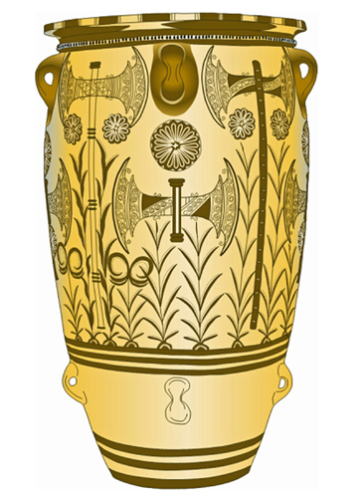 Site: West Storerooms, Room 11-13, West Wing, Knossos Palace Shape & Decoration: Palace style, Large Pithos vessel, “limited edition” for Knossos Palace reed clump of Floral design, double axe and rosette patterns Era: LMII, 1450-1400 BC Museum: HAM, inv. No. 7757 / H1,345mm Local: Central North, Crete Drawing: Eiji OKUBO During the LMIB period of the Late Minoan civilization, around 1450 BC, three Minoan Palaces and countless local mansions and towns on Crete were completely destroyed one after another by the militant Mycenaean invaders from mainland Greece. For about 75 years, until the Knossos Palace finally collapsed in a huge fire around 1375 BC, the skilled craftsmen of the pottery workshops in the East Wing under the rule of the occupying Mycenaeans, established a beautiful pottery style worthy of symbolizing Minoan civilization, which was no exaggeration to say that the “last flower of culture” of the New Palace Era. It was Palace style Ware, which called the most beautiful pottery in the Eastern Mediterranean region at the time and was the “limited edition” for Knossos Palace. The Palace style Ware was a special pottery which developed and improved at the Palace of Knossos, which was after the Mycenaean invasion of Crete around 1450 BC. For this reason, the Palace style Ware have uncovered virtually only from the Knossos Palace ruins, residences adjacent to the palace, and royal cemeteries and tombs scattered a short distance away. In Sir Arthur John Evans' excavations, a large pithos jar with a height of 1,345mm which can be emphasized as the best work of Palace style pottery, from the Rooms 11 to 13 of the West Storerooms, the West Wing of the Knossos Palace. Although it was in a broken state at the time of excavation, but it was concluded that the pithos jar collapsed during the final collapse of the Palace of Knossos, around 1375 BC, from the sacred Northwest Sanctuary Hall, which undoubtedly existed on the upper floor of the West Wing. This large Palace style pithos jar is for decorative purposes. The pattern is basically a Floral design that gives a gentle impression, but the double axe and large rosette, which were the highest worship symbols of Minoan civilization, are expressed majestically in the wide body space. Many works of Palace style ware, a lineage of the Mycenaean civilization on mainland Greece, have been unearthed at Minoan and Mycenaean sites, including beautiful amphora shaped vessels and jugs. However, if it limits to the content of the design among the Palace style pottery which has been unearthed on Crete so far, we can confirm that is not a simple drawing of eight double axes. All patterns of this large ornamental pithos jar, which is accurately depicted with very delicate lines, so that can say to be emphasized as honoring the ruler of Knossos Palace in the highest degree of formality. Therefore, in Minoan pottery, there is no other high-quality art motif that symbolizes reverence than this one. There is no doubt that this large pithos jar was the perfect decoration for the final stage of the Palace of Knossos, and most suitable for decorating the magnificent sacred Northwest Sanctuary Hall on the second floor of the West Wing. The pithos jar was produced in the latter half of the New Palace Era, the Late Minoan civilization LMII period, 1450 to 1400 BC. Related: West Wing, Knossos Palace 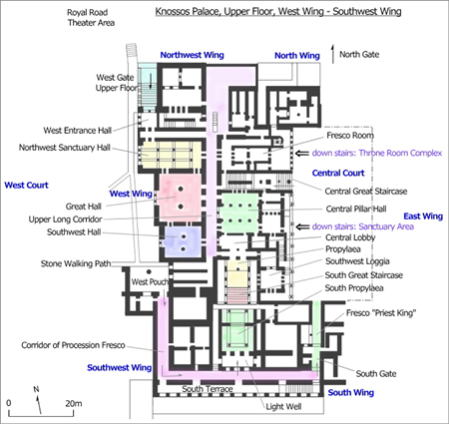 Site: Plan of Upper Floor, West Wing, Knossos Palace West Court, West Pouch, South Entrance, Central Court=ground level Era: MMIIIA-LMIIIA1, 1625-1375 BC Re. information: Papers, Sir Arthur John Evans, “The PALACE of MINOS at KNOSSOS v. II” (1928) Local: Central North, Crete Drawing: Eiji OKUBO GPS: 35°17’53’’N 25°09’47’’E / ALT 95m VI-01 Marine Design style, Elegant Jar 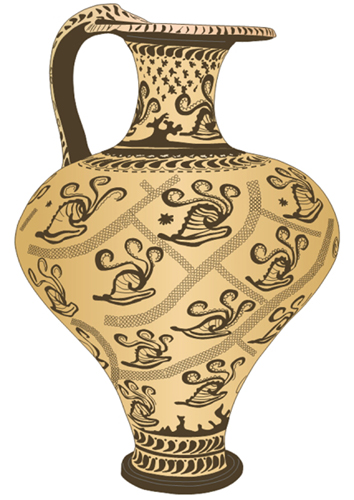 Site: West Wing, Zakros Palace Shape & Decoration: Marine design style, Elegant Jar with argonaut pattern Era: LMIB, 1500-1450 BC Museum: HAM, inv. No. 14098 Local: Easternmost, Crete Drawing: Eiji OKUBO Related: West Wing, Zakros Palace 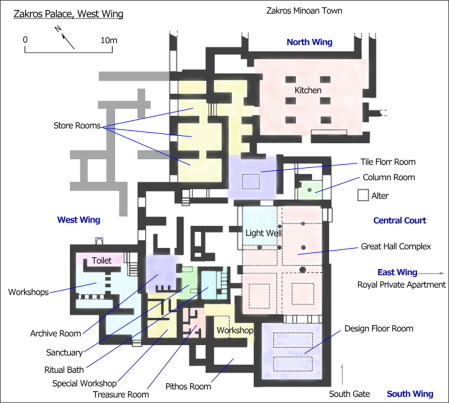 Site: Plan of West Wing, Zakros Palace Era: MMIIIA-LMIB, 1625-1450 BC Local: Easternmost, Crete / 19km southeast from Sitia city Drawing: Eiji OKUBO GPS: 35°05’53’’N 26°15’40’’E / ALT 5m Related: Treasure Room, West Wing, Zakros Palace  Site: Treasure Room, West Wing, Zakros Palace Situation: Baked brick frame (partition board) for jewelry storage Era: MMIIIA-LMIB, 1625-1450 BC Local: Easternmost, Crete Photo: 1982 Related: Rock-crystal Rhyton with partially gold decoration 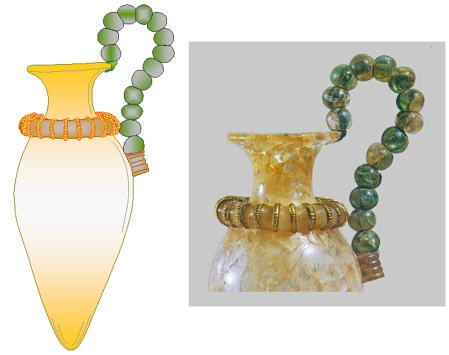 Site: Treasure Room, West Wing, Zakros Palace Shape & Decoration: Rock-crystal Rhyton,” shoulder ring partially decorated with gold Era: LMI, ca. 1500 BC Museum: HAM, inv. No. 2721 / H160mm Local: Easternmost, Crete Drawing: Eiji OKUBO Related: Teardrop-shaped Spartan Basalt Rhyton 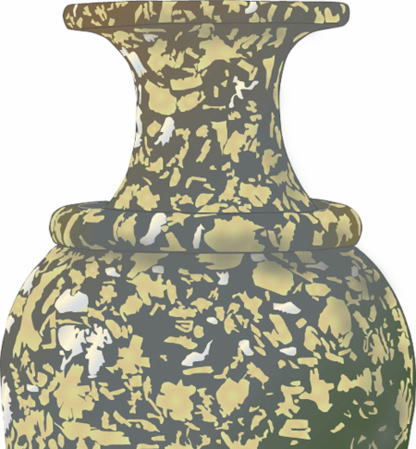 Site: Treasure Room, West Wing, Minoan Zakros Palace Shape & Decoration: Teardrop-shaped Spartan basalt Rhyton, beautiful stone phenocryst Era: LMIA, 1550-1500 BC Museum: HAM, inv. No. 2712 / rhyton H460mm Local: Easternmost, Crete Drawing: Eiji OKUBO XI-08 Leg of (large Bowl vessel) Marine Design style 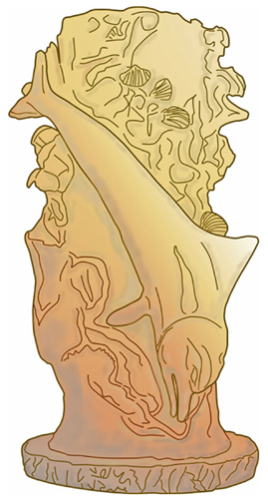 Site: North-South Passage, North Wing, Phaestos Palace Shape & Decoration: Leg of large Bowl vessel? Marine Design style=dolphin, various shellfish Era: MMII, ca. 1700 BC Museum: HAM, inv. No. 18199 / H390mm Local: Messara Plain, Crete Drawing: Eiji OKUBO Related: Minoan Fresco, “Dolphins and Fish”  Site: Queen’s Room, East Wing, Knossos Palace Shape & Decoration: Fresco, “Dolphins and Fish” on hanging/upper wall of north side Era: MMIIIA-LMIB, 1625-1450 BC Museum: HAM Local: Central North, Crete Photo: 1994 Related: Mycenaean Bronze Dagger, “Dolphin” inlay technique 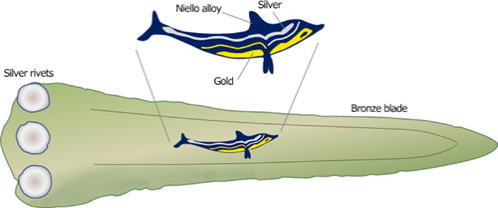 Site: Chamber Tomb 14, Heraion (old name Prosymna) Shape & Decoration: Bronze Dagger of the “Tangles type” a) inlaid decoration=gold, silver, niello alloy=dolphin on each side of the blade b) three silver rivets on the shoulder part Era: LHII, 1500-1400 BC Museum: NAM, inv. No. 8446 dagger length L186mm, dolphin length L38mm Local: Argolis, Peloponnese / 4km south-southeast from Mycenae Palace Drawing: Eiji OKUBO GPS: 37°41'45''N 22°46'21''E / ALT 130m Related: Mycenaean Gold Shallow Cup, Marine Design, “Dolphin” 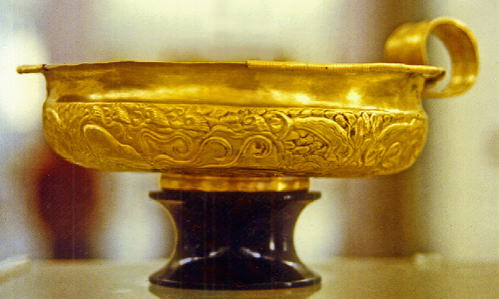 Site: Royal Tholos Tomb, Dendra Shape & Decoration: Shallow Gold Cup, ring-handle Marine design=dolphins, octopus, underwater reef in repoussé cup itself=imported from Minoan Crete, addition of handle at mainland? Era: LHIIIA, 1400-1300 BC Museum: NAM, inv. No. 7341 / mouth diameter D178mm Local: Argolis, Peloponnese Photo: 1987 ---------- |